The Pancake of the River: Unlocking the Secrets of the Spiny Softshell Turtle
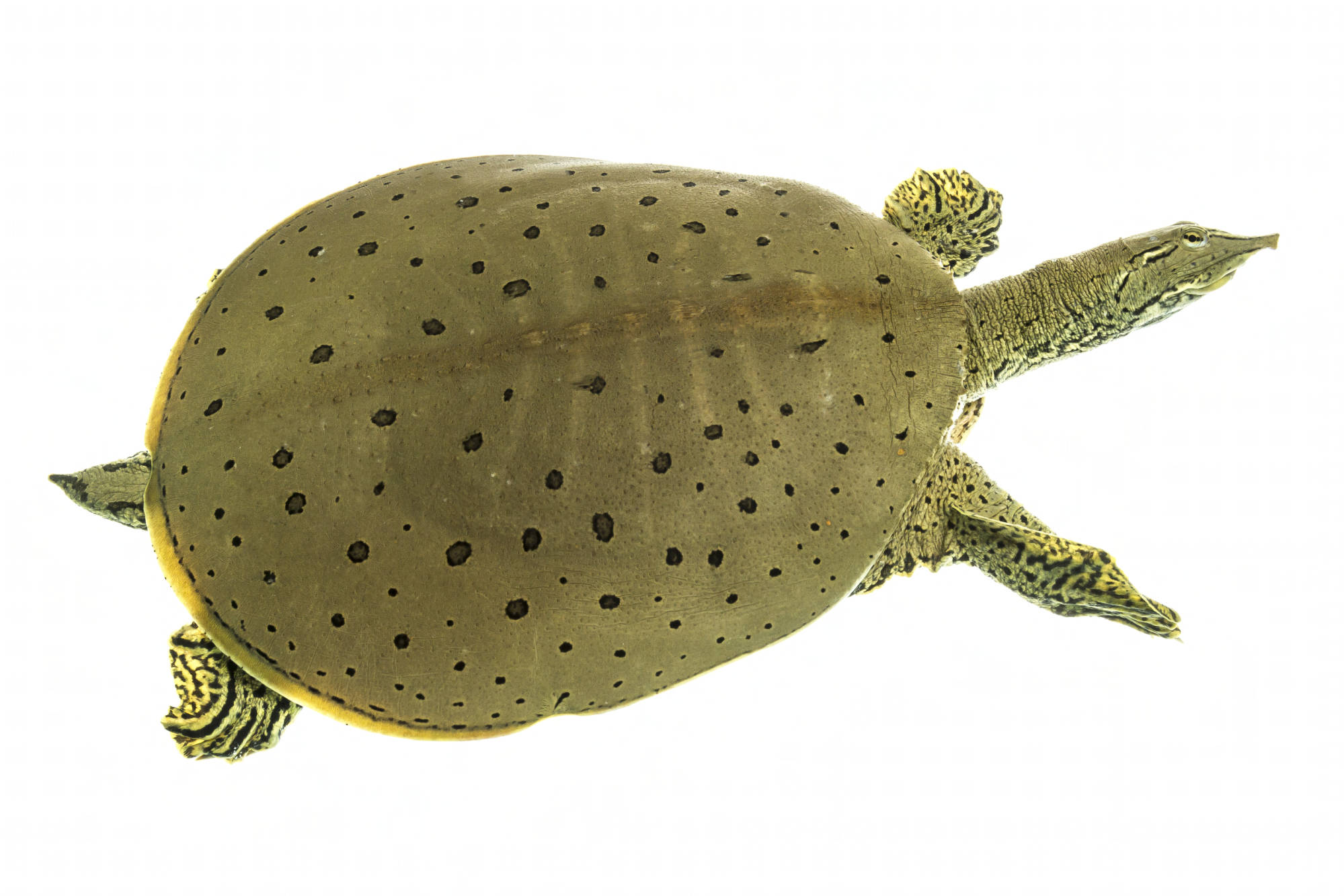
“The Pancake of the River: Unlocking the Secrets of the Spiny Softshell Turtle”
At first glance, you might think nature made a mistake.
A turtle with no hard dome? A body so flat it looks like a pancake left out in the sun? And that nose—long, thin, and ending in two tiny nostrils—more like a snorkel than anything a “proper” turtle should have.
Meet the Spiny Softshell Turtle (Apalone spinifera), a creature that looks as if it came from an alien sketchbook. To the untrained eye, its design makes no sense at all. But as with so many marvels of evolution, every strange curve, every odd feature, every “flaw” is, in fact, a masterpiece of adaptation.
To understand why, we have to step into its world.
First Impressions: The “Wrong” Turtle
If you’ve grown up imagining turtles as slow-moving, dome-shelled reptiles basking on logs, the Spiny Softshell Turtle will shatter that image instantly. It doesn’t have the classic, armored look. Instead of a rigid, high shell, its carapace is thin, leathery, and flexible—covered in tiny cone-shaped bumps (the “spines” in its name) near the neck.
Its body is wide, smooth, and surprisingly hydrodynamic, built not for defense but for speed. And then there’s the nose: a narrow tube extending from its face, ending in a set of nostrils that can poke above the water like a periscope.
To the casual observer, this turtle looks… wrong. Vulnerable. Incomplete.
But the Spiny Softshell Turtle isn’t broken—it’s a specialist. And specialists always have a story.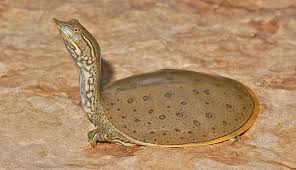
A Creature of Water and Sand
Spiny Softshell Turtles are found in North America, their range stretching from the Great Lakes and the Mississippi River basin to parts of Canada and Mexico. They thrive in freshwater habitats—rivers, lakes, and streams where the bottom is sandy or muddy.
It’s in these environments that their unusual body becomes their greatest advantage.
While most turtles rely on heavy shells for protection, the Spiny Softshell Turtle has gone the opposite way, shedding that armor in favor of agility. A hard shell is great for defense on land, but in fast-moving rivers, it’s like swimming with a backpack full of bricks. The softshell design makes them streamlined—able to dart through the water with surprising bursts of speed, outrunning predators instead of outlasting them.
The Snorkel Nose: Built for Stealth
That peculiar pointy nose? It’s not just for show.
Spiny Softshell Turtles are masters of ambush. They spend hours buried under sand or mud, completely hidden except for the tip of their nose sticking above the surface. This snorkel-like adaptation lets them breathe without revealing their bodies.
They don’t just passively wait, either. Their long necks allow them to shoot out like a striking snake to grab unsuspecting prey—fish, insects, crayfish, and even amphibians.
From a predator’s point of view, there’s nothing there. From the prey’s point of view, there’s suddenly too much there.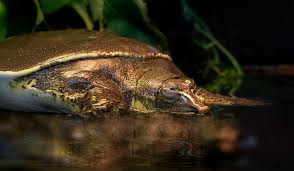
Speed Demons of the Turtle World
Most turtles move through the water with slow, deliberate strokes. The Spiny Softshell Turtle is a sprinter. Its webbed feet are large and powerful, propelling it with such speed that even experienced divers find them difficult to catch.
This agility isn’t just for hunting—it’s a critical survival tool. Without a heavy shell to hide in, the turtle must avoid predators like raccoons, large fish, and birds of prey through speed and stealth.
Breathing Through Their Skin
Perhaps the most fascinating part of the Spiny Softshell Turtle’s design is invisible at first glance: its ability to breathe through its skin.
Like some amphibians, this turtle can extract oxygen directly from the water through specialized areas of skin, especially around its throat and cloaca. This adaptation allows it to stay submerged for long periods, even in cold or murky water, without needing to surface for air.
When the rivers freeze over in winter, they can remain under the ice, relying on this skin-based respiration to survive until spring.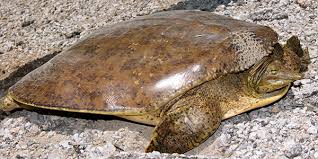
Life in the Current
A day in the life of a Spiny Softshell Turtle is a delicate dance between feeding, avoiding predators, and conserving energy.
In the morning, they might be found basking on sandbanks or flat rocks, soaking up warmth. Unlike most hard-shelled turtles, they’re more skittish—quick to slip into the water at the first sign of danger.
Once in the river, they alternate between active hunting and passive concealment. They can vanish into the sandy bottom in seconds, their soft shells blending perfectly with the substrate. If disturbed, they explode into motion, vanishing into deeper water.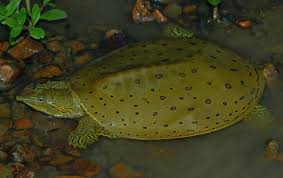
The Mating Season
Spring and summer bring a different kind of urgency—reproduction. Males, smaller and more agile, patrol the shallows, searching for receptive females. Courtship is subtle: a gentle nudge, a chase, a quiet persistence.
Females, much larger than males, choose mates and later crawl onto sandy banks to lay their eggs, often far from water. These nests, while vulnerable to predators like raccoons and foxes, are the turtles’ only investment in their young—once laid, the eggs are left to fate.
Hatchlings emerge weeks later, already equipped with the flat shell and snorkel nose, ready to fend for themselves.
Misunderstood and Overlooked
Because they lack the “classic” turtle appearance, Spiny Softshell Turtles often get overlooked in wildlife discussions. They’re not as photogenic as sea turtles or as familiar as painted turtles. Yet their evolutionary path is every bit as remarkable.
They’ve traded armor for agility, visibility for invisibility, and brute force for finesse. They are living reminders that in nature, there is no single “correct” design—only what works.
Threats in the Modern World
Despite their adaptability, Spiny Softshell Turtles face modern challenges. Habitat destruction is their biggest enemy. Dams alter river flow, reducing sandy nesting areas. Pollution affects the water they rely on for camouflage and breathing. And in some areas, they are still hunted for meat.
Because they depend so heavily on clean, sandy-bottomed rivers, even small changes to their environment can have devastating effects.
Why Their Design Makes Perfect Sense
Every oddity of the Spiny Softshell Turtle is a survival tool:
-
Flat shell – Hydrodynamic for speed, easy to bury in sand for camouflage.
-
Soft, leathery skin – Lighter and more flexible than hard shells, reducing drag in water.
-
Spiny ridges – Provide slight protection and help break up the turtle’s outline for camouflage.
-
Snorkel nose – Allows breathing while fully submerged and hidden.
-
Webbed feet – Perfect for rapid swimming and digging into sand.
-
Skin breathing – Lets them remain underwater for extended periods, even in winter.
What looks strange to us is, in reality, a finely tuned set of evolutionary adaptations.
A Glimpse Into the Future
If we protect their habitats—keeping rivers clean, maintaining natural sandbanks, and reducing human interference—the Spiny Softshell Turtle will continue gliding through North America’s waterways for generations.
If not, their unique design, honed over millions of years, could vanish in a matter of decades. And that would be a loss not just for them, but for the intricate tapestry of life they help weave.
The Lesson They Teach Us
In a world obsessed with “normal” and “perfect,” the Spiny Softshell Turtle is a quiet reminder that survival doesn’t always mean fitting the mold. Sometimes, thriving means breaking it completely.
The next time you see one, don’t think of it as “wrong.” Think of it as exactly right—a living proof that nature never designs without reason.
Because in the rivers they call home, that flat shell and funny nose aren’t oddities. They’re perfection.











